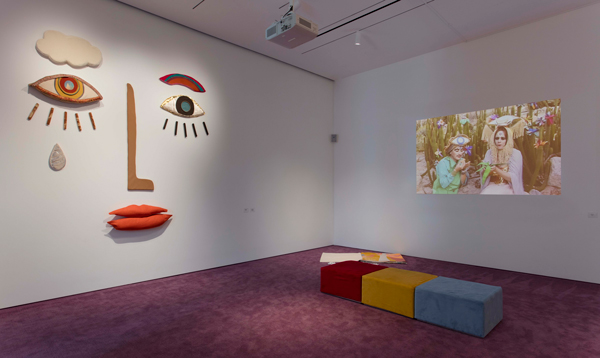When I walked into OURCHETYPES (2018), an installation by Jade Gordon and Megan Whitmarsh at the Hammer Museum’s biennial exhibition “Made in L.A.,” I felt as though I had entered a bubble. The soft purple carpeted floors, the ambient voices emanating from the video projections and the hand-sewn artwork labels, all functioned to create an isolated space that felt as though it was separate from the rest of the museum. Through a combination of sights, sounds, performance and installation, the artists created an alternative, imagined reality that sought to challenge the boundaries that institutions place upon us on a daily basis.

Jade Gordon and Megan Whitmarsh, Installation view, Made in L.A. 2018, June 3-September 2, 2018, Hammer Museum, Los Angeles. Photo: Brian Forrest.
Gordon and Whitmarsh, in their centerpiece video projection, take on the imagined personas of spiritual guides addressing topics like consumerism and the toxicities of the workforce, attempting to expose viewers to new thoughts and ideas. The inherent one-way nature of this video positions the artists’ personas as shamanistic, creating an almost cultish vibe. To the right of the video are eerie-looking white sculptural masks and to the left are giant feminine soft-sculpture face—both reminiscent of rituals and idol worship.

Gordon’s and Whitmarsh’s over-the-top, colorful costumes along with their hamming-up prevents their personas from being wholly believable. As such, the video, accompanied by soft-sculpture everyday objects like potted plants, to-do lists and hairbrushes presented on pedestals, colors the whole installation with a hint of satire. The title of the installation questions the notion of “archetype,” which can be defined as “standard” or “stereotype.” By playing with this term, Gordon and Whitmarsh have imbued it with a sense of agency and ownership, as if we, the viewers, are able to define our own archetypes and standards. The bubble I had walked into was a bubble of irony and playfulness that the artists were using to challenge norms existing in the realworld beyond OURCHETYPES (the museum itself is an institution after all), through a distinctly feminist lens.



